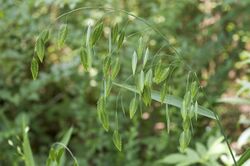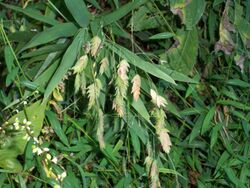Biology:Chasmanthium latifolium
| Chasmanthium latifolium | |
|---|---|

| |
| Chasmanthium latifolium | |
| Scientific classification | |
| Kingdom: | Plantae |
| Clade: | Tracheophytes |
| Clade: | Angiosperms |
| Clade: | Monocots |
| Clade: | Commelinids |
| Order: | Poales |
| Family: | Poaceae |
| Subfamily: | Panicoideae |
| Genus: | Chasmanthium |
| Species: | C. latifolium
|
| Binomial name | |
| Chasmanthium latifolium (Michx.) Yates
| |
Chasmanthium latifolium, known as fish-on-a-fishing-pole, northern wood-oats, inland sea oats, northern sea oats, and river oats is a species of grass native to the central and eastern United States, Manitoba, and northeastern Mexico; it grows as far north as Pennsylvania and Michigan,[1] where it is a threatened species.[2] The species was previously classified as Uniola latifolia (André Michaux).
Description
Chasmanthium latifolium is a cool-season, rhizomatous, perennial grass with culms about 1 m [3 feet] tall.[3] The inflorescence is an open, nodding panicle of laterally compressed (flattened) spikelets. The plant typically grows in wooded areas and riparian zones.[4]
Gardens
It is used in landscaping in North America, where it is noted as a relatively rare native grass that thrives in partial shade; the plant is recommended for USDA hardiness zones 3–9 in acidic sands, loams, and clays.[5][6]
Ecology
It is a larval host plant for the Northern Pearly-Eye, and its seeds are food for birds and mammals.[7] It is also eaten by the caterpillars of the pepper and salt skipper, Bell's roadside skipper, and bronzed roadside skipper butterflies.[8]
References
- ↑ "Plants of the World Online | Kew Science" (in en). https://powo.science.kew.org/?name_id=404466.
- ↑ "Chasmanthium latifolium (Indian Woodoats)". Global Biodiversity Information Facility. http://data.gbif.org/species/13753995.
- ↑ Navarrete-Tindall, Nadia (Summer 2010). "Native Cool-Season Grasses in Missouri". Missouri Prairie Journal 31 (2): 20–25. https://drive.google.com/file/d/1z2tzpePqiydTgEmabGHYaKIOKLp7XrRW/view.
- ↑ "PLANTS Profile for Chasmanthium latifolium (Indian woodoats)". PLANTS database. United States Department of Agriculture. http://plants.usda.gov/java/profile?symbol=CHLA5.
- ↑ "Northern Sea Oats - Ornamental Grasses - University of Illinois Extension". University of Illinois. http://urbanext.illinois.edu/grasses/northern_sea_oats.cfm.
- ↑ "NPIN: Chasmanthium latifolium (inland sea oats)". Native Plant Information Network. University of Texas. http://www.wildflower.org/plants/result.php?id_plant=chla5.
- ↑ "Chasmanthium latifolium". https://plants.ces.ncsu.edu/plants/chasmanthium-latifolium/.
- ↑ "Lady Bird Johnson Wildflower Center - The University of Texas at Austin". https://www.wildflower.org/plants/result.php?id_plant=chla5.
External links
Wikidata ☰ Q5087377 entry
 |


